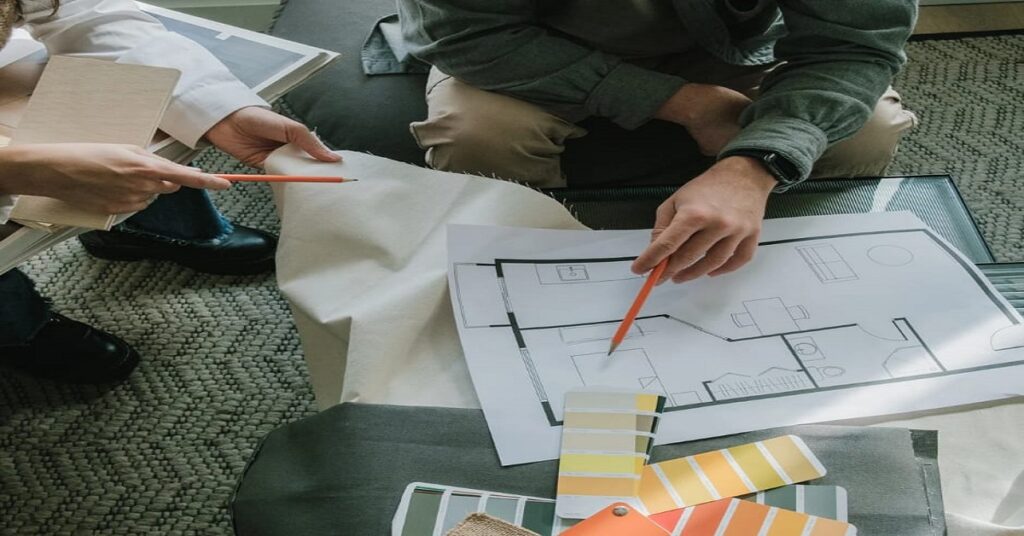Interior design has witnessed a surge in popularity as a career choice in India. But what exactly does an interior designer do, and what does their work profile entail? Collaborating closely with architects, interior designers assist in meticulously planning the layout of establishments, such as houses, offices, and commercial complexes, ensuring optimal utilization of available space. Read more career blogs at college49
Who is an Interior Designer?
The primary role of interior designers is to assist firms and homeowners in designing layouts, structures, color schemes, furnishings, and decorations for their properties. Their objective is to enhance the visual appeal of space while ensuring its functionality. After pursuing a course in interior design, individuals can pursue various career paths, such as becoming interior designers or interior decorators.
They have the option to pursue a Bachelor’s degree in Design (B.Des), Arts (BA), Science (BSc), or a Diploma in Interior Design. Upon obtaining a Bachelor’s degree, candidates can further their education by pursuing postgraduate programs like Master’s in Design (M.Des), Arts (MA), or Science (MSc) in Interior Design. They may also choose to enroll in postgraduate diploma courses to expand their knowledge and expertise in the field.
What does an Interior Designer do?
Interior Design Career Basics
At its core, interior design involves the creation and transformation of living and working spaces to meet the needs and preferences of clients. Interior designers can work independently as freelancers or as part of a design firm. Many designers choose to specialize in a specific area such as residential design, green spaces, or corporate workspaces. Aspiring interior designers often have questions about the requirements for breaking into the field, the potential for entrepreneurship, and the benefits of specialization.
Interior Design in Detail
Becoming a professional interior designer goes beyond having a creative flair. It requires formal education, training, discipline, determination, and strong business and marketing skills. This comprehensive guide provides aspiring interior designers with essential information to navigate their career path effectively.
What is the Eligibility Criteria for Interior Designer?
Here is an overview of interior designing courses, including information on eligibility and fees:
- Diploma in Interior Designing:
- Eligibility: Passed 10th or 10+2 with a minimum of 50% marks from any stream.
- Fees: Please check with the respective institute for specific fee details.
- PG Diploma in Interior Designing:
- Eligibility: Graduation from any discipline with a minimum of 55% marks from a relevant discipline from a recognized university.
- Fees: Please check with the respective institute for specific fee details.
- Bachelor in Interior Design (BA, BSc, BDes, or BArch):
- Eligibility: Passed 10+2 with a minimum of 50% marks from any stream.
- Fees: Please check with the respective institute for specific fee details.
- Master in Interior Design (MA, MSc, or MBA):
- Eligibility: Graduation from any discipline with a minimum of 55% marks from a relevant discipline from a recognized university.
- Fees: Please check with the respective institute for specific fee details.
What is the qualification of an Interior Designer?
Before embarking on a career in interior design, it is crucial to understand the necessary academic qualifications. Here are some key points to consider:
- Completion of 10+2 education is mandatory.
- The required aggregate marks may vary from one institute to another but typically range from 40% to 55%.
- Having computer literacy is an added advantage. Familiarity with technical skills is preferred, as much of the design work is done using computer systems.

What are the courses of an Interior Designer?
Types of Interior Design Courses with Eligibility Requirements
Various universities offer degree programs in Interior Design at the undergraduate and postgraduate levels. The following table provides an overview of the courses offered by these universities along with their durations and eligibility requirements:
| Course Name | Duration | Eligibility |
|---|---|---|
| Bachelor of Interior Design (BID) | 4 years | Completion of 10+2 with a minimum of 50% marks from any stream. |
| B.Des Interior Design | 4 years | Completion of 10+2 with a minimum of 50% marks from any stream. |
| BSc Interior Design | 3 years | Completion of 10+2 with a minimum of 50% marks from any stream. |
| BArch Interior Design | 5 years | Completion of 10+2 with a minimum of 50% marks from any stream. |
| MA Interior Design | 2 years | Graduation in any discipline with a minimum of 55% marks from a relevant field and a recognized university. |
| MSc Interior Design | 2 years | Graduation in any discipline with a minimum of 55% marks from a relevant field and a recognized university. |
| MBA Interior Design | 2 years | Graduation in any discipline with a minimum of 55% marks from a relevant field and a recognized university. |
| Diploma in Interior Design | 1 year | Completion of 10th or 10+2 with a minimum of 50% marks from any stream. |
| Postgraduate Diploma in Interior Designing | 1 year | Graduation in any discipline with a minimum of 55% marks from a recognized university. |
What is the Salary of an Interior Designer?
When it comes to interior designer salaries in India, different organizations offer varying compensation. Here is a list of reputable companies and their respective pay ranges
| Company Name | Average Salary |
|---|---|
| Livspace | Monthly salaries range from Rs 25,000 to 40,000 on average. |
| RSP | Average monthly salaries fall between Rs 25,000 and 30,000. |
| HBA Architecture and Interior Design | Monthly salaries average between Rs 22,000 and 28,000. |
| Godrej and Boyce Manufacturing | Salaries range from Rs 23,000 to 45,000 per month on average. |
| Bonito Designs | Average monthly salaries range from Rs 15,500 to 22,500. |
| Asian Paints | Salaries average between Rs 23,000 and 27,000 per month. |
| Dar-Al-Handasah | Monthly salaries range from Rs 30,000 to 36,000 on average. |
| Shopper’s Stop | Average monthly salaries range from Rs 55,000 to 75,000. |
| McDonald’s | Salaries range from Rs 15,000 to 25,000 per month on average. |
| Landmark Group | Average monthly salaries fall between Rs 45,000 and 60,000. |
How to Become an Interior Designer in India?
Steps to Becoming an Interior Designer
Step 1: Earn a degree in interior design While not always mandatory, most interior design firms prefer candidates with at least a bachelor’s degree in interior design or a related field. Accredited programs that offer coursework in areas like drawing and computer-aided design (CAD) are highly regarded. Many colleges, universities, and specialized art and design institutes offer interior design programs. It’s important to choose a program that is accredited by organizations like the National Association of Schools of Art and Design or the Council for Interior Design Accreditation.
Step 2: Pass the National Council for Interior Design qualification exam Depending on the state, licensure may be required for interior designers. The National Council for Interior Design Qualification (NCIDQ) exam is a common licensing exam that assesses an interior designer’s knowledge and skills. Some states have their own exams, such as the California Council for Interior Design Certification (CCIDC) exam. Obtaining licensure or certification demonstrates professional competence and may enhance job prospects.
Step 3: Gain experience through pro bono projects Starting out in the industry can be challenging without prior work experience. To gain practical experience, consider offering your services for free to friends, family, local non-profit organizations, or small businesses in need of design assistance. Taking on pro bono projects allows you to develop your skills and build a portfolio.
Step 4: Create a professional portfolio A well-organized and visually appealing portfolio is essential for showcasing your skills and attracting potential clients. Include high-quality photographs of your work, design samples, sketches, and any other relevant materials that demonstrate your creativity and expertise. Consider creating an online portfolio to reach a wider audience and stay up to date with industry trends.
Step 5: Seek continuing education opportunities Interior design is a constantly evolving field, and staying updated on industry trends and advancements is crucial. Pursue professional certifications or specialty certificates in areas like sustainable design, corporate interior design, or historic spaces. Attend conferences, workshops, and events organized by professional organizations like the International Interior Design Association, the American Society of Interior Designers, or the Interior Design Society to expand your knowledge and network with industry professionals.
1. Can interior designers work independently or do they need to be part of a firm?
Interior designers can work independently as freelancers or start their own design firms. However, many designers also work for established design firms, which provide them with opportunities for collaboration and a steady client base.
2. How do interior designers ensure compliance with building codes and regulations?
Interior designers are knowledgeable about building codes and regulations and ensure that their designs meet the required safety and accessibility standards. They work closely with architects and contractors to ensure compliance.
3. Can interior designers work independently or do they need to be part of a firm?
Interior designers can work independently as freelancers or start their own design firms. However, many designers also work for established design firms, which provide them with opportunities for collaboration and a steady client base.
4. What is the role of an interior designer?
An interior designer is responsible for creating functional, safe, and aesthetically pleasing spaces by selecting appropriate materials, colors, furnishings, and decor.
5. What qualifications are required to become an interior designer?
While a formal education in interior design is not mandatory, most firms prefer designers with at least a bachelor’s degree in interior design or a related field
6. How can an interior designer stay updated with the latest design trends?
Interior designers can attend design conferences, workshops, and trade shows, read design publications, and participate in online forums and communities to stay informed about the latest trends and innovations.
7. How do interior designers work with clients?
Interior designers collaborate closely with clients to understand their needs, preferences, and budget. They develop design concepts, present proposals, and incorporate client feedback throughout the design process.




